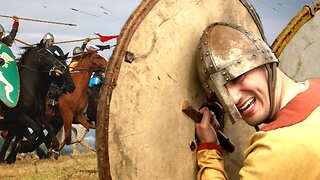Premium Only Content

24. Another River To Cross
In this lecture, we’re going to start with a new move: shoot the tiger. Then
we have a repetition of two previous moves: parry and punch, and sealing
and closing. After that comes the cross hands move. We’ll reach the end of
the Yang-style 40 form with a closing maneuver, and we’ll reach the end of
our course with some final teachings tai chi has to offer.
The Full Yang-Style 40 Form
1. Commencing
2. Grasp the bird’s tail
3. Single whip
4. Step up and raise hands
5. White crane spreads its wings
6. Brush knee and twist step
7. Right hand strums the lute (pipa)
8. Parry and punch
9. Sealing and closing
10. Diagonal flying
11. Punch under elbow
12. Repulse the monkey
13. Fair lady works at the shuttles
14. Part the horse’s mane on both sides
15. Cloud hands
16. Single whip
17. High pat on horse
18. Kick with right heel
19. Box both ears
20. Separate the left foot
21. Turn body and kick with heel
22. Needle at the bottom of the sea
23. Open arms like a fan
24. Snake sticks out its tongue
25. Turn and pat the foot
26. Ride the tiger
27. Snake creeps down
28. Rooster stands on one leg (both sides)
29. Punch groin
30. Grasp the bird’s tail
31. Single whip
32. Snake creeps down
33. Seven stars posture
34. Step back to ride the tiger
35. Turn body and lotus kick
36. Shoot the tiger
37. Parry and punch
38. Sealing and closing
39. Cross hands
40. Closing form
Wān gōng shè hǔ (“Shoot the Tiger)
● The next movement is called wān gōng shè hǔ, which in English
means “shoot the tiger.”
● Bend the knee on the right side of the body so that the thigh is
level and the toes point downward. Turn the waist slightly to the
left and then to the right. Extend both arms to the left at shoulder
level, with both palms facing out.
● Turn the torso slightly to the right and step down with the right
foot, setting the heel down on the floor and turning the toes out.
Turn the waist to the right and shift the weight onto the right foot
to form a Bow Step. Meanwhile, move both palms downward and
rightward in a curve and form two loose fists on the right side of
the body.
● As the waist turns to the left, the left fist punches past the face to
the northeast corner. The right fist draws back to the right temple,
with the back of the hand facing backward. Both wrists are flexed.
Look first at the right fist, then at the left fist.
Jìn bù bān lán chuí (Parry and Punch)
● Up next is a repetition of parry and punch.
● Sit back entirely on the left foot, turning the waist to the left and
turning the left foot out. Release the left fist, rotate the left forearm
outward to turn the palm up and sweep the left hand down past
the hip. The right hand retains the fist, and also sweeps down past
the hip.
● Shift the weight entirely onto the left foot, and step out with the
right foot to the east, landing on the heel. As the right foot steps
out, both hands upward and forward, the right hand leading in a
back fist. The left hand will press forward with the palm open, next
to the right forearm.
● Turn the waist to the right, and pivot the right toes outward (due
south). Shift the weight entirely onto the right foot. Simultaneously,
reach forward with the left hand (keep the arm rounded) and
withdraw and chamber the right fist back to the right hip.
● Step forward with the left foot to make a bow step, and turn the
waist slightly back to the left. Punch forward with the right hand
as you go, past the left palm, which will finish right next to the
right forearm.
Sealing and Closing
● The next movement we’re going to do is a repeat of sealing
and closing.
● Slide the left open palm just under the right forearm, then separate
the two hands to shoulder width. As the two hands separate, both
forearms rotate outward, turning the palms up.
● Sit back entirely onto the right leg, withdrawing both hands into the
front of the chest. As the hands near the torso, the two forearms
rotate inward and turn the palms facing out.
● Shift the weight forward to the front foot again, re-creating the bow
step and push with both hands as you go.
Shí zì shǒu (“Cross Hands”)
● The next movement we’re going to learn is called shí zì shǒu,
which in English means “cross hands.”
● Sit back onto the right foot and turn the waist to the right, pivoting
the left foot to the south. Simultaneously, open both arms to the
45-degree corners.
● Shift the weight back onto the left foot and step in a half-step (to
shoulder width) with the right foot. As you step in with the right
foot, circle both hands and arms downward and inward to cross
at the wrists. Center and sink the weight evenly over both feet,
and rise up to normal standing position, lifting the crossed wrists to
shoulder height.
Shōu shì huán yuán (“Closing Form”)
● The last movement we’re going to learn in this form is called shōu
shì huán yuán, which in English means “closing form.” Simply
separate the hands to shoulder width and slowly lower them to
your sides. Step the left foot next to the right foot.
● That’s the end of the routine. But there’s a bit of tradition that isn’t
precisely part of the choreography. When you finish the routine
and give a bow, you’re bowing to a whole line of people.
● You’re bowing to the person who taught you this form. You’re
bowing to that teacher, and to the teacher that taught them, and to
the teacher behind that teacher, all the way back in an unending
line to the mythical Zhang Sanfeng, who invented tai chi.
What Next?
● So what can you do now that you’ve learned the full Yang-style
40 form? One option is to introduce someone else to tai chi.
Only a few people want to become traditional tai chi teachers,
but you could share a little of what you have learned with a child,
grandchild, coworker, or neighbor—someone that you care about.
● Introducing someone to the path of tai chi is almost the most
generous gift you can give to another person. It’s an introduction
to harmony and balance, everything in life works better when
you’re in balance.
-
 1:17:59
1:17:59
Sarah Westall
7 hours agoDOGE: Crime & Hysteria bringing the Critics & the Fearful - Plus new CDC/Ukraine Crime w/ Dr Fleming
31.2K3 -
 45:39
45:39
Survive History
13 hours ago $3.76 earnedCould You Survive in the Shield Wall at the Battle of Hastings?
38.7K5 -
 1:50:28
1:50:28
TheDozenPodcast
12 hours agoViolence, Abuse, Jail, Reform: Michael Maisey
82.3K4 -
 23:01
23:01
Mrgunsngear
1 day ago $4.41 earnedWolfpack Armory AW15 MK5 AR-15 Review 🇺🇸
72.5K12 -
 25:59
25:59
TampaAerialMedia
1 day ago $2.26 earnedUpdate ANNA MARIA ISLAND 2025
44.2K4 -
 59:31
59:31
Squaring The Circle, A Randall Carlson Podcast
14 hours ago#039: How Politics & War, Art & Science Shape Our World; A Cultural Commentary From Randall Carlson
34.1K3 -
 13:21
13:21
Misha Petrov
14 hours agoThe CRINGIEST Thing I Have Ever Seen…
27K53 -
 11:45
11:45
BIG NEM
10 hours agoWe Blind Taste Tested the Best Jollof in Toronto 🇳🇬🇬🇭
18.7K1 -
 15:40
15:40
Fit'n Fire
13 hours ago $0.38 earnedArsenal SLR106f & LiteRaider AK Handguard from 1791 Industries
16.3K1 -
 8:34
8:34
Mike Rowe
6 days agoWhat You Didn't Hear At Pete's Confirmation Hearing | The Way I Heard It with Mike Rowe
53.7K23